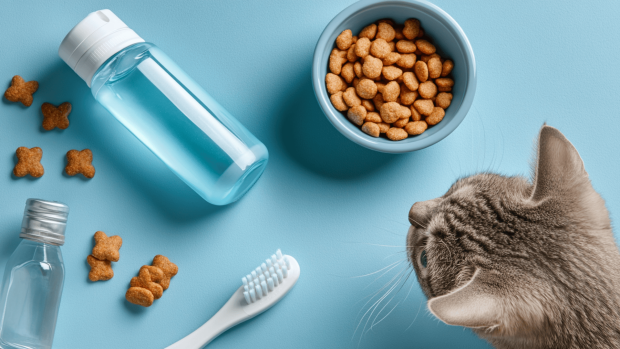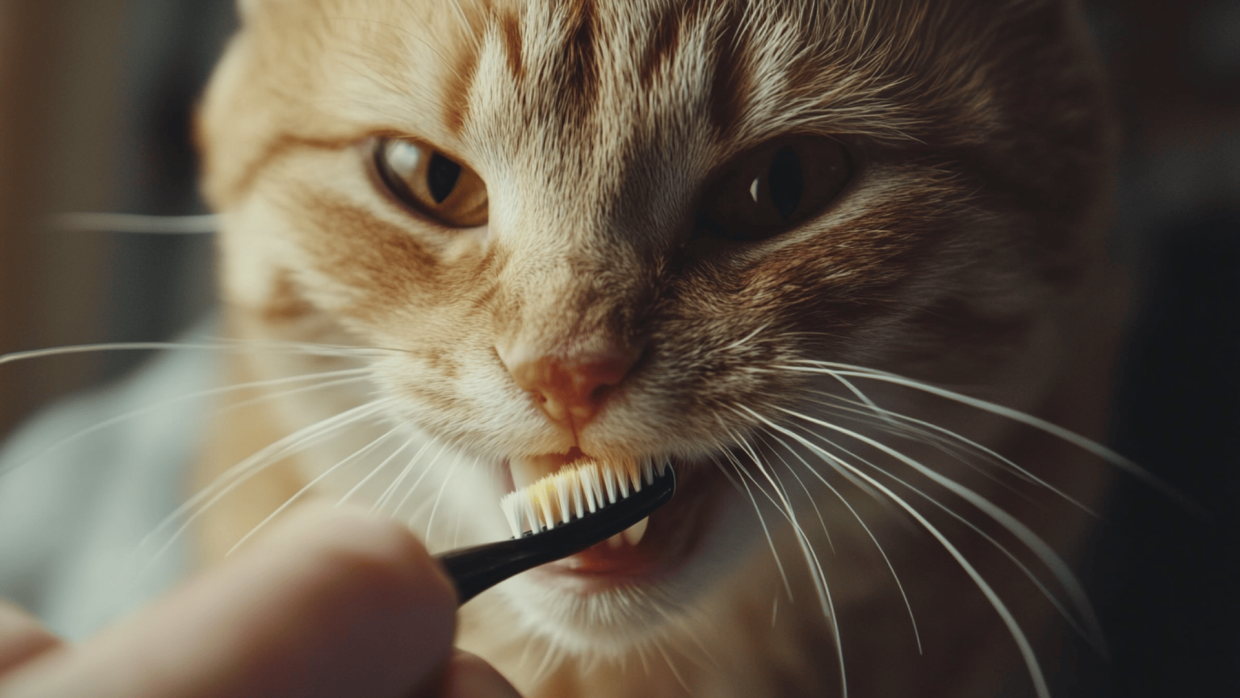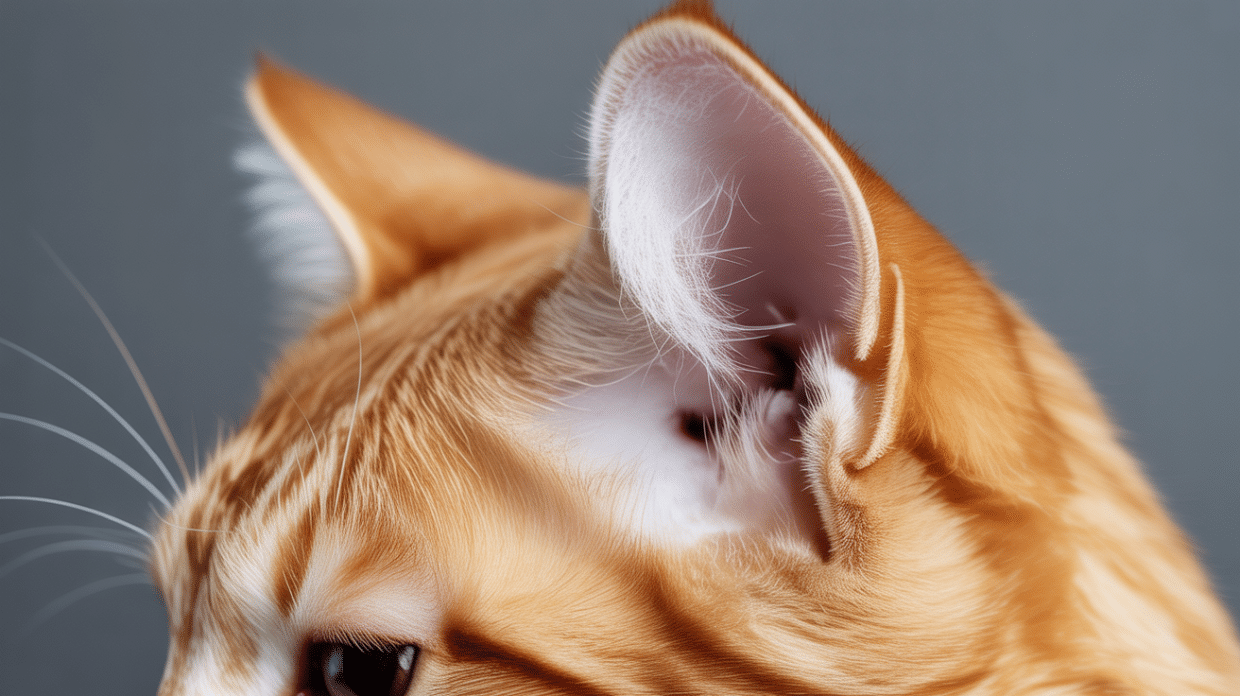Ever noticed yellow or brown stuff building up on your cat’s teeth and wondered if it’s a big deal?
That buildup is called tartar, and while it may seem harmless, it can lead to serious health problems if left unattended. You might be here because you’re not sure what tartar is, how it forms, or what to do about it.
This blog explains everything in plain, easy-to-follow steps. We’ll go over what tartar on cats’ teeth is, how to spot it, why it matters, and what you can do to prevent or remove it.
By the end, you’ll know how to keep your cat’s teeth healthy and avoid expensive vet visits. Ready to find out how much tartar really matters?
What is Tartar and How does it Form?
Tartar is hardened plaque that sticks to your cat’s teeth. It begins as a soft film composed of food particles, bacteria, and saliva, known as plaque.
If plaque isn’t cleaned off regularly, it hardens and turns into tartar. Once that happens, it becomes much harder to remove and can lead to other dental problems.
Tartar usually builds up near the gumline, especially on the back teeth, where it’s harder to reach.
Signs Your Cat Has Tartar Buildup
You don’t need to be a vet to spot tartar. There are a few simple signs that let you know something’s not right.
Visual Indicators
- Yellow, tan, or brown patches on the teeth
- Build-up near the gumline
- Darker spots on the back teeth
Other Symptoms to Look for
- Bad breath that doesn’t go away
- Red or bleeding gums
- Drooling more than usual
- Pawing at the mouth or avoiding food
- A change in eating habits due to pain
If you see any of these signs, it might be time to take action or talk to your vet. Catching tartar early can prevent more serious issues later.
Why Tartar is a Serious Health Risk
Tartar might seem like a small problem, but it can lead to serious health issues if left untreated. It affects more than just your cat’s mouth.
Gum Disease and Infection
When tartar builds up, it irritates the gums. This leads to gingivitis, which causes redness, swelling, and pain.
If it keeps getting worse, it can turn into periodontal disease. That’s when the tissue and bone holding the teeth start to break down.
Tooth Loss and Damage
Tartar can eat away at the roots and bones that support your cat’s teeth. Over time, this may cause teeth to loosen or fall out.
It can also make it painful for your cat to chew or eat properly, and in some cases, may lead to more serious dental problems like resorptive lesions in cats.
Health Risks Beyond the Mouth
The bacteria in tartar can spread through your cat’s bloodstream. This can affect vital organs, such as the heart, kidneys, and liver. In serious cases, it may lead to infections that can impact your cat’s overall health.
Taking tartar seriously isn’t just about fresh breath. It’s about protecting your cat’s well-being from head to tail.
Tartar Removal: Vet vs. At-Home Options
Tartar can’t be ignored, but the good news is that there are ways to deal with it. Some methods need a vet’s help, while others can be done at home with the right tools and care.
Professional Cleaning by a Veterinarian
A vet dental cleaning is the most thorough way to remove tartar. Here’s what to expect:
- Your cat will be put under anesthesia
- The vet uses special tools to scale and polish the teeth
- All visible and hidden tartar is removed
Most cats need a professional cleaning once a year. Some may need it more often if they’re prone to dental issues.
Costs can range from $300 to $700, depending on your area and what’s included. It’s safe, but anesthesia always carries some risks, especially in older cats.
At-Home Tartar Control
You can help prevent tartar from forming with regular at-home care. Here are a few simple methods:
- Brushing: Use a soft toothbrush made for cats
- Toothpaste: Only use cat-safe toothpaste; never human toothpaste
- Wipes and gels: These are quick, easy ways to clean teeth without brushing
- Water additives: Mixed into your cat’s water, they help control bacteria
Even if your cat doesn’t love it at first, gentle daily care goes a long way in stopping tartar from coming back.
Natural Remedies and Supplements
Some natural options may also help slow tartar buildup. Always consult your veterinarian before trying new things.
- Coconut oil: A small amount rubbed on teeth may reduce bacteria
- Dental chews: Help scrape plaque off as your cat chews
- DIY routines: Some owners use gauze-wrapped fingers or natural gels approved by vets
These options aren’t a full replacement for vet care, but they can help support your cat’s dental health in between cleanings.
Best Products to Prevent Tartar in Cats

Using the right products can make a big difference in keeping your cat’s teeth clean. Some are designed to slow down plaque buildup, while others help remove it as your cat eats or plays.
Dental Diets
Special dental food can help clean your cat’s teeth while they chew. Some top options include:
These foods have a special texture that scrubs the teeth and reduces plaque. They’re often recommended by vets for long-term use.
Treats and Toys
Tartar-fighting treats and toys are a great way to sneak in dental care. Look for:
- Greenies Feline Dental Treats
- Oral care toys with textured surfaces
- Chew sticks or natural dental treats
They’re not a cure-all, but they help reduce buildup between brushings.
Toothbrushes and Toothpaste
If you brush your cat’s teeth, using the right tools matters.
Helpful products include:
- Cat-specific toothbrushes or finger brushes: Cats & Puppies Finger Toothbrush
- Enzymatic cat toothpaste (like Virbac or Sentry brands)
- Starter kits for cats new to brushing: Petrodex Dental Care Kit for Cats
Always pick items made for cats—they’re safer and more effective than human products.
Mixing and matching these products can help you build a routine that works for both you and your cat. It’s all about finding what your cat tolerates and sticking with it.
Creating a Dental Care Routine for Your Cat
A simple routine can go a long way in keeping your cat’s teeth healthy. It doesn’t have to be perfect, just consistent.
Daily, Weekly, and Monthly Checklists
Daily:
- Offer dental treats or dental food
- Use water additives if your vet approves
Weekly:
- Brush your cat’s teeth 2–3 times
- Wipe teeth with a dental pad or gauze
Monthly:
- Check for tartar, red gums, or bad breath
- Clean toys and bowls to reduce bacteria
This routine helps prevent tartar and makes future cleanings easier.
When to Schedule Vet Checkups
Most cats should have a dental exam once a year. Go sooner if you notice:
- Bad breath that doesn’t go away
- Bleeding gums or drooling
- Trouble eating or pawing at the mouth
Your vet can tell you if your cat needs a professional cleaning or just a change in routine.
Making Brushing Stress-Free
Start slow and keep it positive. Tips that help:
- Let your cat sniff and lick the toothbrush first
- Use tasty cat toothpaste as a treat
- Brush just one tooth at a time in the beginning
- Follow up with play or cuddle time
The goal is to make brushing part of your cat’s routine, not a battle. With patience, most cats will get used to it.
Final Tips for Keeping Your Cat’s Teeth Healthy
Good dental care isn’t about doing everything perfectly. It’s about doing something regularly.
Consistency over perfection:
Even brushing a few times a week is better than not at all. Don’t worry if your cat won’t let you do everything. Small steps make a big difference over time.
Mixing products for better results:
Using a mix of dental tools can boost your results. Try combining:
- Brushing with dental treats
- Water additives with a dental diet
- Wipes or gels between brushing days
Every bit of effort adds up to a healthier mouth and fewer vet bills. With a little time and care, you can help your cat stay happy, healthy, and pain-free.
Conclusion
Tartar on cats’ teeth might seem like a small issue, but it can lead to big problems if it’s ignored.
In this blog, you learned what tartar is, how it forms, and how to spot the early signs before they get worse. We also covered vet treatments, at-home care, and the best products to help keep your cat’s teeth clean.
Now that you know the risks and solutions, you can start building a simple routine that works for you and your cat. Healthy teeth mean less pain, fewer vet bills, and a happier pet.
Remember, catching tartar early makes a big difference.
Curious about other ways to care for your cat? Check out more helpful tips in our pet health section.






